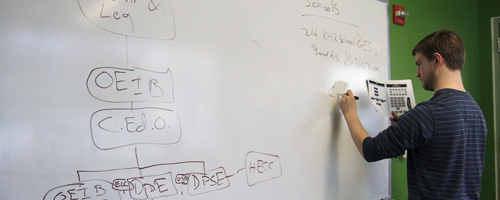Change is in the air for students who receive subsidies for their child care costs from Portland State. Key stakeholders at the Helen Gordon Child Development Center, the Associated Students of Portland State University Children’s Center, the Resource Center for Students with Children and the ASPSU student fee committee have been in talks to redesign the distribution of students’ incidental fees to prioritize giving direct aid to student parents who need help paying for child care—on and off campus.
PSU eyes changes to child care on campus
[portfolio_slideshow id=46733]
Change is in the air for students who receive subsidies for their child care costs from Portland State.
Key stakeholders at the Helen Gordon Child Development Center, the Associated Students of Portland State University Children’s Center, the Resource Center for Students with Children and the ASPSU student fee committee have been in talks to redesign the distribution of students’ incidental fees to prioritize giving direct aid to student parents who need help paying for child care—on and off campus.
Now, students with children who enroll their children in on-campus child care centers pay for care that has been significantly subsidized by student fees. Faculty and staff with children at HGCDC are billed a standard rate, but because student fees subsidize the center’s operation, those rates are artificially lower. In the future, that money will be shifted directly to student aid.
The SFC is in charge of the roughly $14 million in incidental fees that are collected from students along with tuition. The committee prepares a budget with these funds and then passes it along to the university president for approval.
“We don’t have to subsidize entire programs,” said Nick Rowe, the chair of the SFC. “We want to be more deliberate and conscious of the financial need that a student will have with respect to child care.”
Over time, the SFC has decided to move toward weaning on-campus child care providers from the student fees that have subsidized their operations budgets. This process, in turn, may raise the cost of on-campus child care for faculty and staff.
The Jim Sells Child Care Assistance Program is expected to play a more significant role in distributing the subsidies from student fees to student-parents. As it is now, the program offers subsidies for child care to eligible student-parents—44 students this term—who are economically vulnerable.
Unlike the child care provided on campus by the HGCDC and the ASPSU Children’s Center, the Jim Sells program allows parents to use their subsidies on or off the PSU campus, and the program is entirely need-based. Child care centers on campus subsidize their rates for student-parents, faculty and staff regardless of economic need.
The HGCDC is run by PSU’s graduate school of education with the dual purpose of providing child care for the children of PSU students and staff and serving as a laboratory for studies in early childhood education and related fields.
While the child care provided at the HGCDC is highly praised by PSU administrators, staff and student-parents, the center—which has a capacity of 176—is only able to accommodate a fraction of PSU students’ children. Of the families enrolled at the HGCDC, one-third are faculty and staff.
A presidential task force that met in 2010–11 determined that one-fifth of students on campus have children and that a significant portion of those student-parents are single parents. In addition to the logistical complications involved in securing child care for their children, these student-parents often struggle with the financial burdens of covering the cost of child care.
Lisa Wittorff, coordinator at the RCSC, said that throughout the current talks over child care subsidies at PSU, many feel strongly that student fees should be directed toward subsidizing care for student-parents, not for faculty and staff families.
The exact details of a redistribution of child care subsidies are part of “a long-term question,” Wittorff said. “But the short-term [question] is how to make distributions of student fee subsidies more equitable.”
One new plan for serving PSU students with children that has all child care providers on campus excited is the possibility of a short-term care facility. Michele Toppe, dean of Student Life, said that the 2010–11 presidential task force findings also recommended that the university provide more short-term care options for students.
“I hear from students a lot that this is the kind of care that they need,” Toppe said. “Something happens and [the student] needs child care in order to take care of something on campus.”
Toppe mentioned a short-term care program at Oregon State University that was a good model for PSU’s future facility.
Though a short-term care facility for students with children is one more plan in the works, Wittorff said that the planners have a few specifics in mind. The facility would be separately housed from the Smith Memorial Student Union and a certain number of hours of child care would be free to parents who used short-term child care only on occasion.
“I’m hopeful that it would be open in the fall,” Wittorff said.
Rowe said that talks about redistributing child care subsidies for students with children will involve some difficult conversations, but overall, he’s happy with the process.
“I’m extremely satisfied and proud of the way we’ve moved forward with the stakeholders,” he said.
For now, the SFC is moving forward in tandem with on-campus child care providers to steer toward more equitable access to care for students with children.






